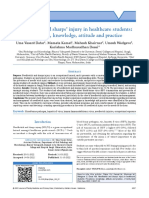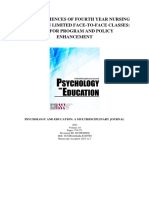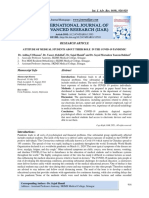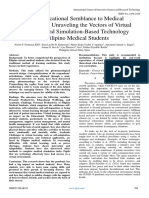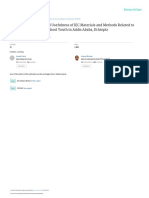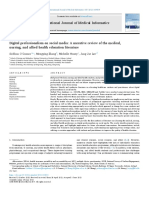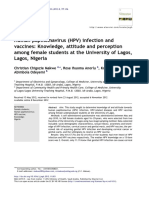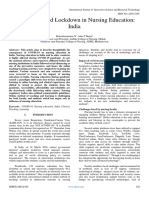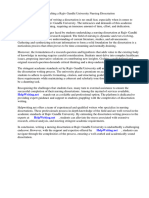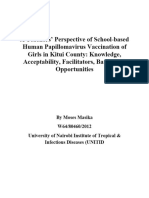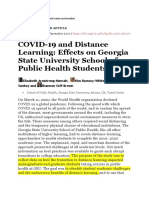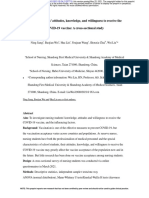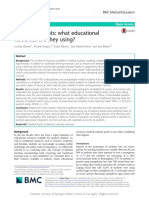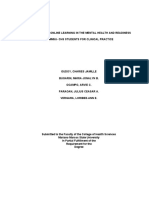Professional Documents
Culture Documents
Barriers Affecting Students With Special Needs in Accessing Comprehensive Sexual and Reproductive Health Services and Rights On Campus A Case of Kwame Nkrumah University
0 ratings0% found this document useful (0 votes)
8 views5 pagesStudents with special needs face a lot
obstacles during their studies on campus. In many
institutions
Original Title
Barriers Affecting Students With Special Needs in Accessing Comprehensive Sexual and Reproductive Health Services and Rights on Campus a Case of Kwame Nkrumah University (2)
Copyright
© © All Rights Reserved
Available Formats
PDF, TXT or read online from Scribd
Share this document
Did you find this document useful?
Is this content inappropriate?
Report this DocumentStudents with special needs face a lot
obstacles during their studies on campus. In many
institutions
Copyright:
© All Rights Reserved
Available Formats
Download as PDF, TXT or read online from Scribd
0 ratings0% found this document useful (0 votes)
8 views5 pagesBarriers Affecting Students With Special Needs in Accessing Comprehensive Sexual and Reproductive Health Services and Rights On Campus A Case of Kwame Nkrumah University
Students with special needs face a lot
obstacles during their studies on campus. In many
institutions
Copyright:
© All Rights Reserved
Available Formats
Download as PDF, TXT or read online from Scribd
You are on page 1of 5
Volume 7, Issue 12, December – 2022 International Journal of Innovative Science and Research Technology
ISSN No:-2456-2165
Barriers Affecting Students with Special Needs in
Accessing Comprehensive Sexual and Reproductive
Health Services and Rights on Campus a Case of
Kwame Nkrumah University
Misheck Samakao
Kwame Nkrumah University
Abstract:- Students with special needs face a lot Table of Acronyms
obstacles during their studies on campus. In many CSRH: Comprehensive Sexual and Reproductive Health
institutions of higher learning there is often little PEP: Post –Exposure Prophylaxis
attention given in the provision of the services with HIV: Human Immunodeficiency virus
respect to students living with disabilities. Students with AIDS: Acquired immunodeficiency syndrome
special needs are 3-4 times at higher risks of contracting SNE: Students with Special Needs
HIV/AIDS as compared to the ordinary students. The AU: African Union
institutions of higher learning mostly do not take this KNU: Kwame Nkrumah university
reality into consideration in terms of planning and MOH: Ministry of Health
repackaging of services in order to meet this challenge. HEI: Higher education Institution
Students with special needs suffer gross violation of I. INTRODUCTION
human rights during their period of study in institutions
of higher education leading to high levels of stigma, high Universities are known to be places of high levels of
exposure to HIV/AIDS risks, high unhygienic conditions freedom with students experiencing high levels of
and poor sanitary services, lack of attention and even civilization. With the African Agenda of 2063 providing
denial of access to health, sexual and reproductive health free access to comprehensive sexual and reproductive health
services on campus both directly and indirectly. services to all youths in society, there appears to be a big
challenge with respect to accessibility and availability for
The study used qualitative research methodology. comprehensive sexual and reproductive health for students
Both probabilistic and non-probability techniques were with special needs (Obasi et al, 2019). Students with special
used as sampling techniques. needs are also human beings with feelings just like any other
including sexual desires. In fact, they have even more
The findings of the study showed that students complicated limitations. When it comes to sexual drives, it
living with disabilities had difficulties in accessing becomes very difficult to fully socialise and get the services
comprehensive sexual and reproductive health(CSRH) they need through peer interaction. This is because they face
services. They reported long distances to the facility, stigma and isolations from the rest of the student’s
stigma, negative attitudes from medical staff including community and their peer. However, sometimes it is the
communication barriers and myths. medical personnel who would subject them to long queues,
lack of confidentiality and failure to exercise courtesy and
It was recommended that comprehensive sexual privacy, including serious language and communication
and reproductive health services need to be repackaged barriers (Karimu 2017).
effectively in order to meet the demand from students
living with disabilities on campus. There was also need to In universities and colleges, students with special
create more robust awareness and sensitization needs have suffered many limitations with respect to
programs to specifically address challenges faced by accessibility and availability of comprehensive sexual and
students with special needs. The study contributed to the reproductive health services, thereby leading to high sexual
body of empirical knowledge relevant to policy makers, risky behaviour and increasing their exposure to infections
academicians and planners in the fight of HIV/AIDS of diseases and unwanted pregnancies (Burke et al. 2017).
pandemic.
A. Statement of Problem
Keywords:- Comprehensive Reproductive Health, Students with special needs have had challenges in
Disability, Students with Special Needs, Accessibility, accessing their sexual and reproductive health services on
Availability, HIV/AIDS, Vulnerability, Barriers. campus. They face amongst other factors, stigma, lack of
information, language barriers, lack of privacy and
sometimes long queues and shortages of the stock
IJISRT22DEC1568 www.ijisrt.com 2018
Volume 7, Issue 12, December – 2022 International Journal of Innovative Science and Research Technology
ISSN No:-2456-2165
(Abdurahman et al. 2022). Despite the university being the order to get a full view of the phenomenon under
centre of civilization, it has continued to record high HIV investigations. The research sample included the following;
risks cases as the students with special need are increasing students (30) health workers (3) administrative staff (2)
in population but still cannot get what they need. If this academic staff (2) organisation with disabilities (1) and the
situation is not addressed, Students witjh special needs total shall be 38.
(SNE) will be highly exposed to human immunodeficiency
virus/acquired immunodeficiency syndrome(HIV/AIDS) B. Ethical Considerations
and other sexually transmitted Infections (STIs) as they have The study took into account the ethical requirements in
limited access to the Comprehensive Sexual Reproductive its process. The application was submitted to the research
Health services on campus. Since SNE are already and ethical committee at Kwame Nkrumah University to
vulnerable, this situation if left unchecked might lead to seek for clearance of the study prior to the actual
high pregnancy rates and high HIV/AIDS infections rates undertakings. The clearance was given and the consent were
sought from all research participants that took part in the
B. Objectives study accordingly.
To establish the availability of CSRH services on
campus for students living with disabilities. IV. REVIEW FINDINGS
To assess levels of awareness of the CSRH amongst
students living with disabilities A. Levels of awareness Amongst Students Living with
To ascertain levels of accessibility to CSRH affecting Disabilities
students with special needs on campus The findings of the study indicate that slightly above
To ascertain the barriers affecting students with special half (58%) of the respondents were aware about the
needs in accessing CSRH on campus availability of the compressive sexual and reproductive
To determine measures that could mitigate the barriers health on campus. The rest (42%) were not aware of the
affecting students with special needs in accessing service. From the number that was aware of the availability
Comprehensive Sexual Reproductive Health Services on of the service, some also indicated knowledge of condoms,
campus. counselling and testing but they expressed ignorance about
the availability of post-exposure prophylaxis (PEP), and
II. SIGNIFICANCE OF THE STUDY other related services. However, when further asked about
the reliability of the services on campus, the majority of
This study is very critical as it shall help SNE to have those who accessed them indicated the services were very
access to CSRH services on campus. It shall also create reliable. Further, it can be observed many respondents
awareness and enhance planning for the effective provision indicated that the quality was also good in term of the
of health care services to students with special need. Above conditions of the products and services that they received.
all, this study is basically going to help ensure prevention of
unwanted pregnancies and also prevention of sexually B. Barriers in accessing Comprehensive sexual and
transmitted diseases from the students living with reproductive health
disabilities. Furthermore, planners, policy makers and health The most common barriers that respondents indicated
care providers will be empowered to repackage their included the myths, privacy, distance and staff attitudes
services to executively provide additional help to SNEs on towards students with special needs. Of the barriers
campus. mentioned the myths and staff attitudes ranked in the first
and second positions while privacy and distance followed
III. RESEARCH METHODOLOGY respectively. The majority of the students living with
disabilities mentioned that they had difficulties in accessing
The study used qualitative research methodology. An the services from the clinic on the basis of the trading myths
in-depth explorative view was used to explore, describe and and the negative staff attitudes as well as the common
explain the phenomenon under investigation through the practice of recording details when they accessed
sharing of experiences, values and opinions. The study was contraceptives which they felt was an infringement on their
anchored on phenomelogical philosophical perspective as it rights of privacy.
focused on real life situation searching for human
experiences in a normal environmental setup. C. Levels of HIV/AIDS exposure and risk behaviour
amongst SNE students
A. Sampling, Data Collection and Analysis The findings of the further revealed that the students
The sample size used was 38 and it comprised of with special needs had high pressure with regards to sexual
students with special needs, health care providers, academic demands from the student’s community. They indicated that
staff and administrative staff. The data was collected using the most form of disabilities under high attack included
the semi-structured questionnaires and interview guides. It students living with albinism where the majority of students
further engaged focused group discussions with SNEs and were trying to experiment how sex feels with someone
special interviews with both administrators and the care living with albinism. The majority mentioned that they were
providers. The study sample was collected using both approached on the daily basis for sexual favours with all
probability and non-probabilistic methods called purposive sorts of temptations and allurements. The majority of the
sampling and random sampling techniques respectively in in rest indicated that they still had very high sexual feelings
IJISRT22DEC1568 www.ijisrt.com 2019
Volume 7, Issue 12, December – 2022 International Journal of Innovative Science and Research Technology
ISSN No:-2456-2165
and they needed enough protection against the spread of B. Barriers affecting accessing of CSRH for students living
diseases and other sexually transmitted infections. One of with disabilities
the respondents interviewed indicated that they were asked Amongst the critical barriers exposed in the study are
that where do you take condoms when you get them from myths. The majority of the university community believe
the clinic? Another students living with albinism was asked that students living with disabilities do not have sexual
as to why she wanted condoms and when she went back in feelings and as such they are not expected to seek for family
the same week, the care provider quizzed her loudly “you planning services or any other related services. Similarly,
again?” the majority of students have indicated that even care
providers show visible sign of surprise whenever they would
D. Measures to mitigate factors that lead to high sexual risk see a person living with disabilities coming to access
behaviour among SNE condoms or related services. This mystical misconception
When students with special needs were interviewed as that students living with disabilities are not expected to have
to what could be the solution towards the challenges being sex makes a lot of them avoid seeking services from the
faced with respect to accessibility they indicated that they clinic, but resort to either buy at times in remote places. On
needed management interventions in order to have the average a student struggles with the problem of money and
problem addressed. They further stated there was a need to as such it becomes very difficult if they are not able to get
create awareness and sensitization against the availability of what they need which they think is useful within walkable
CSRH products across the campus. This they indicated distances but rather board a taxi to go and look for condoms
would help to change the staff attitudes and practices in whose cost is less than the cost of boarding bus or taxi. This
order to address the barriers. situation might put a lot on them on high risk as they might
resolve to use unprotected sex.
V. DISCUSSION OF THE RESEARCH FINDINGS
Secondly, there are negative attitudes held by the care
A. Levels of Awareness providers on campus with respect to students living with
It has been observed that the levels the awareness on disabilities. Most care providers have challenges when
comprehensive sexual and reproductive health amongst dealing with students with special needs, For instance there
students living with disabilities are very low. The majority is communication breakdown as they always need a
do not know about all the services that could be possibly translator who might not be readily available.
available on campus for the purposes of HIV/AIDS
prevention. The low awareness levels have great potential to Furthermore, it has been mentioned that there are still
cause high HIV/AIDS risks and related complications such challenges with privacy of the clinic. The location of the
as unwanted pregnancies amongst students with special clinic is situated very close to female hostels on campus.
needs. The low awareness levels were attributed to the fact This in essence makes it hard for the male students to seek a
there were already communication barriers existing between service as they would be seen by the female students and
the students with hearing impairments, the blind and the easily being suspected of being sick. This prevents a big
dumb. This makes all efforts of awareness difficulty on number of male students from getting health services from
campus unless the information is repackaged differently. the university clinic. Further, a sizable percentage of
This could pose a danger in terms of possible HIV/AIDS students most of whom with vision impairments also
risks and unwanted pregnancies because all the students are complained of long distance from the rooms to the location
of reproductive age and indicated that they were already of the clinic. This is understandably clear when one
sexually active. The population of the students living with considers the visually impaired students who always need an
disabilities is increasing daily on campus and this could assistant in order to move from one area of the campus to
further lead to more complications with respect to the spread the next one. There is need therefore to find a way to solve
of the disease if no extra efforts are invested to curtail the the problem of distance as well. The limitation and the
unpleasant ordeals on campus. There is need to keep stock finding of this study are exactly in line with what Loope
of the contraceptives readily available for higher (2011) found out in his study that distance, negative staff
accessibility to all students living with disabilities on attitudes and communication barriers are main challenges
campus. This finding is in line with the findings of Scarvey faced by students living with disabilities in accessing the
(2017) who clearly indicated in his research work that most medical health care especially CRSH on campus. Calibre
students living with disabilities find it hard to access the (2021) also stated that these problems on paper look trivial
CSRH on campus due the nature of natural limitations but they are serious when one considers the state of the
existing with them. His counterpart Cadley(2021) further students with special needs. In view of this therefore Charity
argued that accessibility is not easy with respect to students (2020) recommended that special attention must be invested
with special needs and as such the care providers must in the way services are packaged for the sake of the students
always go an extra mile in order to close this gap. There is with special needs on campus.
need for example to repackage the products as suggested by
Muller (2019) that information on CSRH must be packed in
formats that would reach the students with special needs in a
special manner otherwise they would remain on the higher
risk exposure of being susceptible to HIV/AIDS scourge and
other related problems.
IJISRT22DEC1568 www.ijisrt.com 2020
Volume 7, Issue 12, December – 2022 International Journal of Innovative Science and Research Technology
ISSN No:-2456-2165
C. Levels of HIV/AIDS exposure and risks towards the VI. CONCLUSION
pandemic
The population of students living with disabilities is Students living with disabilities are at a higher risk
highly as risk when it comes to Sexual risk behaviour from spreading of the HIV/AIDS pandemic on campus.
because of peer pressure coming from ordinary students They face more challenges with respect to peer pressure,
whose population is so high. For example, students want to limited resources, long distances to the health facility, long
experiment especially on the students living with albinism. queue, negative attitudes from caregivers and also
The majority of the students are always looking for information and language barriers. Since, students living
opportunities to get sexual experience with someone living with disabilities are of reproductive age and also sexually
with disabilities and as such they too have much pressure active, it is important that extra efforts be invested in
coming from student’s community with all sorts of repackaging the programs that aim at reaching this minority
attractions to lure the students living with disabilities to fall group on campus in the most efficient and effective way.
for the presents and classified gifts in exchange for sexual
favours. Some students with special needs may not There is also need to identify some students from the
continuously resist the temptations and this is more reason hostels to be trained as peer educators and also as focal point
why they need contraceptives in order to prevent the spread persons with information and products well repackaged to
of diseases as well the unwanted pregnancies. The findings serve students living with disabilities on campus.
of this study are in tandem with the findings from another
study conducted by Chally (2021) that showed that students ACKNOWLEDGMENTS
with disabilities are a minority compared with the rest of the
ordinary students and they may be at high risk in such an It is my privilege and honour to take this opportunity to
environment that has high numbers of students who might acknowledge specific people that massively made sacrifices
already be sexually active. to contribute to this project immensely. Firstly, I wish to
acknowledge Janet Chitsino a final year student for being
D. Proposed measures to mitigate the spread of HIV/AIDS instrumental in her duties as research assistant and also
amongst students living with disabilities. facilitator and link to the group of students with various
It was highly recommended that for the highlighted special needs. She also provided transcribing services and
barriers above there is need to create awareness and interpretation of sign language during some tedious
sensitization campaigns in order to mitigate the information interviews that cost us a lot of resources and time.
gaps that are currently prevailing on campus. Information
must be repackaged to suit the specific users that include Special thanks again go to Ms Natasha Mulenga for
students with hard hearing, those with visual impairment being committed and consistent in the organisations of
and those with hard speech. Specific information must be research schedules and logistics, before during and after
tailored to reach the students with special need on campus. the study.
Further special programs must be created pre-tailored to I wish to thank also Mrs Doreen Chilombo an ardent and
target the care-givers with knowledge and communication veteran psychosocial counsellor and mentor for
sign language skills so that they are able to attend to the provision of support and consistent collaboration in the
students with special need without much difficulties. process of data collection and insights in the
Besides they must also be sensitized against having negative coordination of key stakeholders.
attitudes towards this section of the campus grouping. They I wish also to take this chance to commend my family
need to be extra careful so that whatever they say or do is for the support and mutual encouragements before,
not wrongly interpreted. during and after the project. My son kisu and my
daughter hope were ever on point to render the much
Additionally, more funding is required in order to needed moral support. Despite the late hours of
enable the students with special needs to have improved investment into this project they never gave up on me
services of CSRH stocked in many other strategic points for but instead continued to rally behind me at all times.
easier accessibility at all cost. For example, in each block of Furthermore, I wish to also recognise Kwame Nkrumah
hotels where they stay, one student need to be trained as university management for giving us the permission to
peer counsellor so that they could act as strategic point for proceed with the study. My current employer, Kwame
effective distribution of condoms and other specific Nkrumah university had trust and confidence in making
services. it possible for me and my team to engage in this research
work at such a difficulty time when the university was
Moreover, it also strongly recommended that the very busy with a lot of equally important assignments
university must provide enough rooms to be able to offer across the lifeline of the university business.
effective counselling services for both genders males and Most importantly. I give all the glory and praise to the
females respectively. Lord God Almighty, the creator of the heavens and
earth, who has been my guide and source of strength for
the blessing and special favour endowed upon me and
my team to run this race successfully.
IJISRT22DEC1568 www.ijisrt.com 2021
Volume 7, Issue 12, December – 2022 International Journal of Innovative Science and Research Technology
ISSN No:-2456-2165
REFERENCES [14]. Tanabe M(2015) Intersecting sexual and reproductive
health and disability in humanitarian settings: risks,
[1]. Abdurahman C et al (2022) Sexual and reproductive needs, and capacities of refugees with disabilities in
health services utilization and associated factors Kenya, Nepal, and Uganda. Sexuality and disability.
among adolescents attending secondary schools. [15]. Tilahun T et al (2021) Assessment of access and
MM. Reprod Health. 2022 Jul utilization of adolescent and youth sexual and
[2]. Bankole A et al (2017) Sexual behavior, knowledge reproductive health services in western Ethiopia.
and information sources of very young adolescents in Reprod Health. 2021 Apr 23;
four sub-Saharan African countries.
[3]. Burke E, et al (2017) A qualitative study to explore
the barriers and enablers for young people with
disabilities to access sexual and reproductive health
services in Senegal. Reproductive health matters.
[4]. Debeaudrao P et al (2020)The multidimensional
vulnerability of people with disability to HIV
infection: Results from the handiSSR study in
Bujumbura, Burundi. Centre Population et
Developpement, (Ceped), Institut de recherche pour
le d_eveloppement (IRD) and Paris University,
Inserm ERL 1244, 45 rue des Saints-P_eres,
[5]. Denno DM et al (2015) Effective strategies to
provide adolescent sexual and reproductive health
services and to increase demand and community
support., Hoopes AJ, Chandra-Mouli V. J Adolesc
Health. 2015 Jan;56(1 Suppl):S22-41
[6]. Hunt X et al (2017) The sexual and reproductive
rights and benefit derived from sexual and
reproductive health services of people with physical
disabilities in South Africa: beliefs of non-disabled
people. Reproductive health matters.
[7]. Karimu A (2017) Exploring the sexual and
reproductive health issues of visually impaired
women in Ghana. Reproductive health matters.
[8]. Kassa TA et al (2016) Sexual and reproductive health
of young people with disability in Ethiopia: a study
on knowledge, attitude and practice: a cross-sectional
study. Globalization and health. 2016;12:5.
[9]. Ngilangwa DP et al (2016) Accessibility to sexual
and reproductive health and rights education among
marginalized youth in selected districts of Tanzania.
[10]. Obasi M et al (2019) Sexual and reproductive health
of adolescents in schools for people with disabilities.
Journal List Pan African series. Med J v.33; 2019
PMC6815493. Published online 2019 Aug 14. doi:
10.11604/pamj.2019.33.299.18546.pamj
[11]. Odo AN et al (2018). Sexual and reproductive health
services (SRHS) for adolescents in Enugu state,
Nigeria: a mixed methods approach BMC Health
Serv Res.
[12]. Onukwugha FI et al (2019) Views of Service
Providers and Adolescents on Use of Sexual and
Reproductive Health Services by Adolescents: A
Systematic Review MA. Afr J Reprod Health. 2019
Jun
[13]. Pacifique Ndayishimiye P et al (2019) Availability,
accessibility, and quality of adolescent Sexual and
Reproductive Health (SRH) services in urban health
facilities of Rwanda: a survey among social and
healthcare providers.
IJISRT22DEC1568 www.ijisrt.com 2022
You might also like
- Boscovich G5 ActionDocument24 pagesBoscovich G5 ActionSky BejeranoNo ratings yet
- Needlestick and Sharps Injury in Healthcare.70Document7 pagesNeedlestick and Sharps Injury in Healthcare.70Uma DatarNo ratings yet
- Lived Experiences of Fourth Year Nursing Students On Limited Face-To-Face Classes: Basis For Program and Policy EnhancementDocument46 pagesLived Experiences of Fourth Year Nursing Students On Limited Face-To-Face Classes: Basis For Program and Policy EnhancementPsychology and Education: A Multidisciplinary JournalNo ratings yet
- Malocclusion: Prevalence and Determinants Among Adolescents of Karachi, PakistanDocument11 pagesMalocclusion: Prevalence and Determinants Among Adolescents of Karachi, PakistanodenmanuelfbNo ratings yet
- Bias in Recruitment A Focus On Virtual InterviewsDocument6 pagesBias in Recruitment A Focus On Virtual InterviewsNupur SinghNo ratings yet
- Attitude of Medical Students About Their Role in The Covid-19 PandemicDocument4 pagesAttitude of Medical Students About Their Role in The Covid-19 PandemicIJAR JOURNALNo ratings yet
- Article Quali 4Document13 pagesArticle Quali 4kenneth.xuan55No ratings yet
- Galang Et Al.Document26 pagesGalang Et Al.Angelo BiluanNo ratings yet
- The Effect of Mobile Learning Application in Enhancing Students' Knowledge of Caring Sepsis PatientsDocument7 pagesThe Effect of Mobile Learning Application in Enhancing Students' Knowledge of Caring Sepsis PatientsIJPHSNo ratings yet
- Background: Article HistoryDocument9 pagesBackground: Article Historyeishca fananiNo ratings yet
- Nursing Virtual Return Demonstration Affecting Capitol University Students: A Phenomenological StudyDocument27 pagesNursing Virtual Return Demonstration Affecting Capitol University Students: A Phenomenological StudyJeffrey TVNo ratings yet
- Impacts of COVID-19 On The School Experience of Children and Adolescents With Special Educational Needs and DisabilitiesDocument8 pagesImpacts of COVID-19 On The School Experience of Children and Adolescents With Special Educational Needs and DisabilitiesFenny ThresiaNo ratings yet
- From Educational Semblance To Medical Hodgepodge Unraveling The Vectors of Virtual Education and Simulation-Based Technology To Filipino Medical StudentsDocument14 pagesFrom Educational Semblance To Medical Hodgepodge Unraveling The Vectors of Virtual Education and Simulation-Based Technology To Filipino Medical StudentsInternational Journal of Innovative Science and Research TechnologyNo ratings yet
- Perceived Sufficiency and Usefulness of IEC Materials and Methods Related To HIVAIDS Among High School Youth in Addis Ababa, EthiopiaDocument13 pagesPerceived Sufficiency and Usefulness of IEC Materials and Methods Related To HIVAIDS Among High School Youth in Addis Ababa, EthiopiaBarangay MotibotNo ratings yet
- Challenges in Accessing Sexual and Reproductive Health Services by People With Physical Disabilities in Kampala, UgandaDocument9 pagesChallenges in Accessing Sexual and Reproductive Health Services by People With Physical Disabilities in Kampala, UgandaFlorence Kyoheirwe MuhanguziNo ratings yet
- Chapter 1 Group 3 STEM 12 Y8Document10 pagesChapter 1 Group 3 STEM 12 Y8John Cedric D. CortezNo ratings yet
- 1 s2.0 S0022480420308301 MainDocument4 pages1 s2.0 S0022480420308301 MainAgariadne Dwinggo SamalaNo ratings yet
- J Ijmedinf 2021 104514Document8 pagesJ Ijmedinf 2021 104514Shofiyah WatiNo ratings yet
- Autistic College Students and COVID-19Document23 pagesAutistic College Students and COVID-19Catarina GrandeNo ratings yet
- The Effect of COVID-19 Pandemic On US Medical Students in Their Clinical YearsDocument3 pagesThe Effect of COVID-19 Pandemic On US Medical Students in Their Clinical YearsOmarNo ratings yet
- The Detrimental Impacts of Smart Technology Device Overuse Among School Students in Kuwait: A Cross-Sectional SurveyDocument12 pagesThe Detrimental Impacts of Smart Technology Device Overuse Among School Students in Kuwait: A Cross-Sectional SurveyFaithlyn Riche YocorNo ratings yet
- HPV Knowledge Among Female Students in NigeriaDocument8 pagesHPV Knowledge Among Female Students in NigeriapangaribuansantaNo ratings yet
- Comprehensive Evaluation of Knowledge and Perceptions Regarding Geriatric Dentistry Among Saudi Arabian Dental StudentsDocument11 pagesComprehensive Evaluation of Knowledge and Perceptions Regarding Geriatric Dentistry Among Saudi Arabian Dental StudentsAli FaridiNo ratings yet
- Impact of Covid Lockdown in Nursing Education IndiaDocument4 pagesImpact of Covid Lockdown in Nursing Education IndiaInternational Journal of Innovative Science and Research Technology100% (1)
- Level of Gender Sensitivity in Radiologic PatientsDocument27 pagesLevel of Gender Sensitivity in Radiologic PatientsJohn Paul CuaNo ratings yet
- Effectiveness Ethiopia A4Document11 pagesEffectiveness Ethiopia A4Jennifer PoperetschnukNo ratings yet
- Article 45Document11 pagesArticle 45ROSANo ratings yet
- PIIS0002934321004964Document5 pagesPIIS0002934321004964FinkaNo ratings yet
- Rajiv Gandhi University Nursing DissertationDocument5 pagesRajiv Gandhi University Nursing DissertationWriteMyPaperPleaseUK100% (1)
- Use of and Attitudes and Knowledge About Pap Smears Among Women in KuwaitDocument18 pagesUse of and Attitudes and Knowledge About Pap Smears Among Women in KuwaitHanisha EricaNo ratings yet
- Medical Students: What Educational Resources Are They Using?Document8 pagesMedical Students: What Educational Resources Are They Using?Farhad JabarNo ratings yet
- Thesis-Final Draft1-2Document52 pagesThesis-Final Draft1-2Bernadeth BaduaNo ratings yet
- 2021 Article 2811Document7 pages2021 Article 2811Anggoro OctaNo ratings yet
- Hivaids Related Knowledge Attitude Risk Perception and Sexual BehaviorDocument5 pagesHivaids Related Knowledge Attitude Risk Perception and Sexual BehaviorIJARP PublicationsNo ratings yet
- Article - INFUSION - OF - AGE-FRIENDLY - PRINCIPLES - INTO - CURRICULADocument1 pageArticle - INFUSION - OF - AGE-FRIENDLY - PRINCIPLES - INTO - CURRICULAHarlene ArabiaNo ratings yet
- Op-Ed: Pandemics and Accessibility 1Document6 pagesOp-Ed: Pandemics and Accessibility 1Ariana Sanchez AlvarezNo ratings yet
- Healthcare 10 00040 v2Document10 pagesHealthcare 10 00040 v2SWATI GAURNo ratings yet
- Multimedia in Education: What Do The Students Think?: SciencedirectDocument9 pagesMultimedia in Education: What Do The Students Think?: SciencedirectMuhammad RamadhanNo ratings yet
- A Survey of E-Learning Methods in Nursing and Medical Education During COVID-19 Pandemic in IndiaDocument12 pagesA Survey of E-Learning Methods in Nursing and Medical Education During COVID-19 Pandemic in IndiaANITA HUTAURUKNo ratings yet
- The Meaning of Virtual Return Demonstrations To A Nursing Student of Capitol University: A Phenomenological InquiryDocument17 pagesThe Meaning of Virtual Return Demonstrations To A Nursing Student of Capitol University: A Phenomenological InquiryJeffrey TVNo ratings yet
- Thesis HPV Study in Kitui + AppendicesDocument104 pagesThesis HPV Study in Kitui + AppendicesHimanshu ShahNo ratings yet
- Shirin, OA3Document6 pagesShirin, OA3Ghazi UmerNo ratings yet
- COVID-19 and Distance Learning: Effects On Georgia State University School of Public Health StudentsDocument19 pagesCOVID-19 and Distance Learning: Effects On Georgia State University School of Public Health StudentszohraNo ratings yet
- Nurse Education in PracticeDocument7 pagesNurse Education in PracticeArdhyBagusNo ratings yet
- FileDocument19 pagesFileTanushikha SangwanNo ratings yet
- Comprehensive Sexuality Education in Zambian SchooDocument1 pageComprehensive Sexuality Education in Zambian SchooKayabwe GuyNo ratings yet
- I. Research TitleDocument10 pagesI. Research TitleSantiano ShaneNo ratings yet
- 1 s2.0 S187940682100254X MainDocument8 pages1 s2.0 S187940682100254X MainGretell HenriquezNo ratings yet
- Topic 2 GRP 8Document11 pagesTopic 2 GRP 8Maica MaicsNo ratings yet
- Research/Capstone Project Final Report AbstractDocument12 pagesResearch/Capstone Project Final Report AbstractGomar TanNo ratings yet
- Incorporating Bioethics Education into School CurriculumsFrom EverandIncorporating Bioethics Education into School CurriculumsNo ratings yet
- Nursing Students' Attitudes, Knowledge, and Willingness To Receive The COVID-19 Vaccine: A Cross-Sectional StudyDocument25 pagesNursing Students' Attitudes, Knowledge, and Willingness To Receive The COVID-19 Vaccine: A Cross-Sectional StudyDaveNo ratings yet
- 5223-Article Text-23037-2-10-20200913Document10 pages5223-Article Text-23037-2-10-20200913m.sandra12340No ratings yet
- Universitatea de Vest "Vasile Goldiş" Din Arad: Student: Patrinjei Bogdan Alexandru TD. Anul II - GR - IIDocument4 pagesUniversitatea de Vest "Vasile Goldiş" Din Arad: Student: Patrinjei Bogdan Alexandru TD. Anul II - GR - IIP?TR�NJEI BOGDAN- ALEXANDRUNo ratings yet
- Medical Students What Educational Resources Are THDocument9 pagesMedical Students What Educational Resources Are THlidawatiNo ratings yet
- UntitledDocument12 pagesUntitledDella ANo ratings yet
- Annals of Medicine and SurgeryDocument9 pagesAnnals of Medicine and SurgeryjuanNo ratings yet
- Thesis Proposal Manuscript FINAL Group 4 Gudoy Et Al.Document93 pagesThesis Proposal Manuscript FINAL Group 4 Gudoy Et Al.JOHN JAY PAUL BALICNANGNo ratings yet
- Prevalence and Drivers of HIV Stigma Among Health Providers in Urban India: Implications For InterventionsDocument12 pagesPrevalence and Drivers of HIV Stigma Among Health Providers in Urban India: Implications For InterventionsRosaliaNo ratings yet
- A Study To Assess The Knowledge and Practice of Mensural Hygiene Among Adolescents Girls at SchoolDocument4 pagesA Study To Assess The Knowledge and Practice of Mensural Hygiene Among Adolescents Girls at SchoolEditor IJTSRDNo ratings yet
- Advancing Healthcare Predictions: Harnessing Machine Learning for Accurate Health Index PrognosisDocument8 pagesAdvancing Healthcare Predictions: Harnessing Machine Learning for Accurate Health Index PrognosisInternational Journal of Innovative Science and Research TechnologyNo ratings yet
- Diabetic Retinopathy Stage Detection Using CNN and Inception V3Document9 pagesDiabetic Retinopathy Stage Detection Using CNN and Inception V3International Journal of Innovative Science and Research TechnologyNo ratings yet
- Comparatively Design and Analyze Elevated Rectangular Water Reservoir with and without Bracing for Different Stagging HeightDocument4 pagesComparatively Design and Analyze Elevated Rectangular Water Reservoir with and without Bracing for Different Stagging HeightInternational Journal of Innovative Science and Research TechnologyNo ratings yet
- Design, Development and Evaluation of Methi-Shikakai Herbal ShampooDocument8 pagesDesign, Development and Evaluation of Methi-Shikakai Herbal ShampooInternational Journal of Innovative Science and Research Technology100% (3)
- Terracing as an Old-Style Scheme of Soil Water Preservation in Djingliya-Mandara Mountains- CameroonDocument14 pagesTerracing as an Old-Style Scheme of Soil Water Preservation in Djingliya-Mandara Mountains- CameroonInternational Journal of Innovative Science and Research TechnologyNo ratings yet
- Cyberbullying: Legal and Ethical Implications, Challenges and Opportunities for Policy DevelopmentDocument7 pagesCyberbullying: Legal and Ethical Implications, Challenges and Opportunities for Policy DevelopmentInternational Journal of Innovative Science and Research TechnologyNo ratings yet
- The Impact of Digital Marketing Dimensions on Customer SatisfactionDocument6 pagesThe Impact of Digital Marketing Dimensions on Customer SatisfactionInternational Journal of Innovative Science and Research TechnologyNo ratings yet
- The Utilization of Date Palm (Phoenix dactylifera) Leaf Fiber as a Main Component in Making an Improvised Water FilterDocument11 pagesThe Utilization of Date Palm (Phoenix dactylifera) Leaf Fiber as a Main Component in Making an Improvised Water FilterInternational Journal of Innovative Science and Research TechnologyNo ratings yet
- Dense Wavelength Division Multiplexing (DWDM) in IT Networks: A Leap Beyond Synchronous Digital Hierarchy (SDH)Document2 pagesDense Wavelength Division Multiplexing (DWDM) in IT Networks: A Leap Beyond Synchronous Digital Hierarchy (SDH)International Journal of Innovative Science and Research TechnologyNo ratings yet
- Formulation and Evaluation of Poly Herbal Body ScrubDocument6 pagesFormulation and Evaluation of Poly Herbal Body ScrubInternational Journal of Innovative Science and Research TechnologyNo ratings yet
- Auto Encoder Driven Hybrid Pipelines for Image Deblurring using NAFNETDocument6 pagesAuto Encoder Driven Hybrid Pipelines for Image Deblurring using NAFNETInternational Journal of Innovative Science and Research TechnologyNo ratings yet
- Electro-Optics Properties of Intact Cocoa Beans based on Near Infrared TechnologyDocument7 pagesElectro-Optics Properties of Intact Cocoa Beans based on Near Infrared TechnologyInternational Journal of Innovative Science and Research TechnologyNo ratings yet
- Explorning the Role of Machine Learning in Enhancing Cloud SecurityDocument5 pagesExplorning the Role of Machine Learning in Enhancing Cloud SecurityInternational Journal of Innovative Science and Research TechnologyNo ratings yet
- A Survey of the Plastic Waste used in Paving BlocksDocument4 pagesA Survey of the Plastic Waste used in Paving BlocksInternational Journal of Innovative Science and Research TechnologyNo ratings yet
- A Review: Pink Eye Outbreak in IndiaDocument3 pagesA Review: Pink Eye Outbreak in IndiaInternational Journal of Innovative Science and Research TechnologyNo ratings yet
- Navigating Digitalization: AHP Insights for SMEs' Strategic TransformationDocument11 pagesNavigating Digitalization: AHP Insights for SMEs' Strategic TransformationInternational Journal of Innovative Science and Research TechnologyNo ratings yet
- Automatic Power Factor ControllerDocument4 pagesAutomatic Power Factor ControllerInternational Journal of Innovative Science and Research TechnologyNo ratings yet
- Hepatic Portovenous Gas in a Young MaleDocument2 pagesHepatic Portovenous Gas in a Young MaleInternational Journal of Innovative Science and Research TechnologyNo ratings yet
- Studying the Situation and Proposing Some Basic Solutions to Improve Psychological Harmony Between Managerial Staff and Students of Medical Universities in Hanoi AreaDocument5 pagesStudying the Situation and Proposing Some Basic Solutions to Improve Psychological Harmony Between Managerial Staff and Students of Medical Universities in Hanoi AreaInternational Journal of Innovative Science and Research TechnologyNo ratings yet
- Review of Biomechanics in Footwear Design and Development: An Exploration of Key Concepts and InnovationsDocument5 pagesReview of Biomechanics in Footwear Design and Development: An Exploration of Key Concepts and InnovationsInternational Journal of Innovative Science and Research TechnologyNo ratings yet
- The Effect of Time Variables as Predictors of Senior Secondary School Students' Mathematical Performance Department of Mathematics Education Freetown PolytechnicDocument7 pagesThe Effect of Time Variables as Predictors of Senior Secondary School Students' Mathematical Performance Department of Mathematics Education Freetown PolytechnicInternational Journal of Innovative Science and Research TechnologyNo ratings yet
- Mobile Distractions among Adolescents: Impact on Learning in the Aftermath of COVID-19 in IndiaDocument2 pagesMobile Distractions among Adolescents: Impact on Learning in the Aftermath of COVID-19 in IndiaInternational Journal of Innovative Science and Research TechnologyNo ratings yet
- Enhancing the Strength of Concrete by Using Human Hairs as a FiberDocument3 pagesEnhancing the Strength of Concrete by Using Human Hairs as a FiberInternational Journal of Innovative Science and Research TechnologyNo ratings yet
- Drug Dosage Control System Using Reinforcement LearningDocument8 pagesDrug Dosage Control System Using Reinforcement LearningInternational Journal of Innovative Science and Research TechnologyNo ratings yet
- Securing Document Exchange with Blockchain Technology: A New Paradigm for Information SharingDocument4 pagesSecuring Document Exchange with Blockchain Technology: A New Paradigm for Information SharingInternational Journal of Innovative Science and Research TechnologyNo ratings yet
- Intelligent Engines: Revolutionizing Manufacturing and Supply Chains with AIDocument14 pagesIntelligent Engines: Revolutionizing Manufacturing and Supply Chains with AIInternational Journal of Innovative Science and Research TechnologyNo ratings yet
- Formation of New Technology in Automated Highway System in Peripheral HighwayDocument6 pagesFormation of New Technology in Automated Highway System in Peripheral HighwayInternational Journal of Innovative Science and Research TechnologyNo ratings yet
- Perceived Impact of Active Pedagogy in Medical Students' Learning at the Faculty of Medicine and Pharmacy of CasablancaDocument5 pagesPerceived Impact of Active Pedagogy in Medical Students' Learning at the Faculty of Medicine and Pharmacy of CasablancaInternational Journal of Innovative Science and Research TechnologyNo ratings yet
- Supply Chain 5.0: A Comprehensive Literature Review on Implications, Applications and ChallengesDocument11 pagesSupply Chain 5.0: A Comprehensive Literature Review on Implications, Applications and ChallengesInternational Journal of Innovative Science and Research TechnologyNo ratings yet
- The Making of Self-Disposing Contactless Motion-Activated Trash Bin Using Ultrasonic SensorsDocument7 pagesThe Making of Self-Disposing Contactless Motion-Activated Trash Bin Using Ultrasonic SensorsInternational Journal of Innovative Science and Research TechnologyNo ratings yet
- CitationCJ4-CB Checklists B v1.2Document4 pagesCitationCJ4-CB Checklists B v1.2Joao Vitor RojasNo ratings yet
- Galvanized and Black Malleable Iron Pipe Fittings SpecificationsDocument24 pagesGalvanized and Black Malleable Iron Pipe Fittings SpecificationsdeniNo ratings yet
- QY25K5-I Technical Specifications (SC8DK280Q3)Document11 pagesQY25K5-I Technical Specifications (SC8DK280Q3)Everton Rai Pereira Feireira100% (1)
- Automation & Control Esst en 200804Document356 pagesAutomation & Control Esst en 200804Sveinn Rúnar JúlíussonNo ratings yet
- Acer Veriton S480G Service ManualDocument90 pagesAcer Veriton S480G Service ManualAndreea Georgiana ChirilaNo ratings yet
- IIT BOMBAY RESUME by SathyamoorthyDocument1 pageIIT BOMBAY RESUME by SathyamoorthySathyamoorthy VenkateshNo ratings yet
- Kunduz Tutor Job Apply Question 1Document2 pagesKunduz Tutor Job Apply Question 1anirbanNo ratings yet
- Đề Minh Họa 2020 Số 23 - GV Trang Anh - Moon.vnDocument22 pagesĐề Minh Họa 2020 Số 23 - GV Trang Anh - Moon.vnLily LeeNo ratings yet
- Arduino - Decision Making StatementsDocument20 pagesArduino - Decision Making StatementsJohn Clifford Ambaic JayomaNo ratings yet
- TM-1870 AVEVA Everything3D - (2.1) Draw Administration (CN)Document124 pagesTM-1870 AVEVA Everything3D - (2.1) Draw Administration (CN)yuehui niuNo ratings yet
- 611k01 Kicatalog C Ka Us 1Document8 pages611k01 Kicatalog C Ka Us 1Ean LeeNo ratings yet
- Trends in Structural Systems and Innovations for High-Rise Buildings over the Last DecadeDocument53 pagesTrends in Structural Systems and Innovations for High-Rise Buildings over the Last DecadeNarasimhaReddy PangaNo ratings yet
- Lesson Plan 2 Sine Rule and Cosine RuleDocument8 pagesLesson Plan 2 Sine Rule and Cosine Ruleapi-280114661No ratings yet
- Sist-En-6101-2016 .Document9 pagesSist-En-6101-2016 .lokelooksNo ratings yet
- PC 5400 PC 5500Document53 pagesPC 5400 PC 5500ArturHeiseNo ratings yet
- An Introduction To Pascal Programming MOD 2010Document5 pagesAn Introduction To Pascal Programming MOD 2010Johnas DalusongNo ratings yet
- Assembly Transmission Volvo A40GDocument52 pagesAssembly Transmission Volvo A40GNanang SetiawanNo ratings yet
- The Scientific MethodDocument4 pagesThe Scientific MethodRob LovNo ratings yet
- SECURE ROAD BLOCKERS PREVENT VEHICLE ATTACKSDocument2 pagesSECURE ROAD BLOCKERS PREVENT VEHICLE ATTACKSMuhammad Tahir QamarNo ratings yet
- ManupptDocument65 pagesManupptKrishanarju VenkatesanNo ratings yet
- Hardware Devices Used in Virtual Reality TechnologiesDocument6 pagesHardware Devices Used in Virtual Reality TechnologiesTheMoon LightNo ratings yet
- Plyometric Training Programs For Young Soccer Players: A Systematic ReviewDocument7 pagesPlyometric Training Programs For Young Soccer Players: A Systematic ReviewsteNo ratings yet
- Cartoon Network, Boomerang & TCM TV Rate Card July - SeptemberDocument11 pagesCartoon Network, Boomerang & TCM TV Rate Card July - SeptemberR RizalNo ratings yet
- Frame Fit Specs SramDocument22 pagesFrame Fit Specs SramJanekNo ratings yet
- Optimization Module For Abaqus/CAE Based On Genetic AlgorithmDocument1 pageOptimization Module For Abaqus/CAE Based On Genetic AlgorithmSIMULIACorpNo ratings yet
- Analisis Efektivitas Inklusi Keuangan Di BMT Syariah Riyal: PendahuluanDocument25 pagesAnalisis Efektivitas Inklusi Keuangan Di BMT Syariah Riyal: PendahuluanEma Rina SafitriNo ratings yet
- Test 420001 PDFDocument13 pagesTest 420001 PDFmaria100% (1)
- Calmark - Birtcher 44 5 10 LF L DatasheetDocument2 pagesCalmark - Birtcher 44 5 10 LF L DatasheetirinaNo ratings yet
- 6907 6 52 0040Document35 pages6907 6 52 0040amitkumar8946No ratings yet

